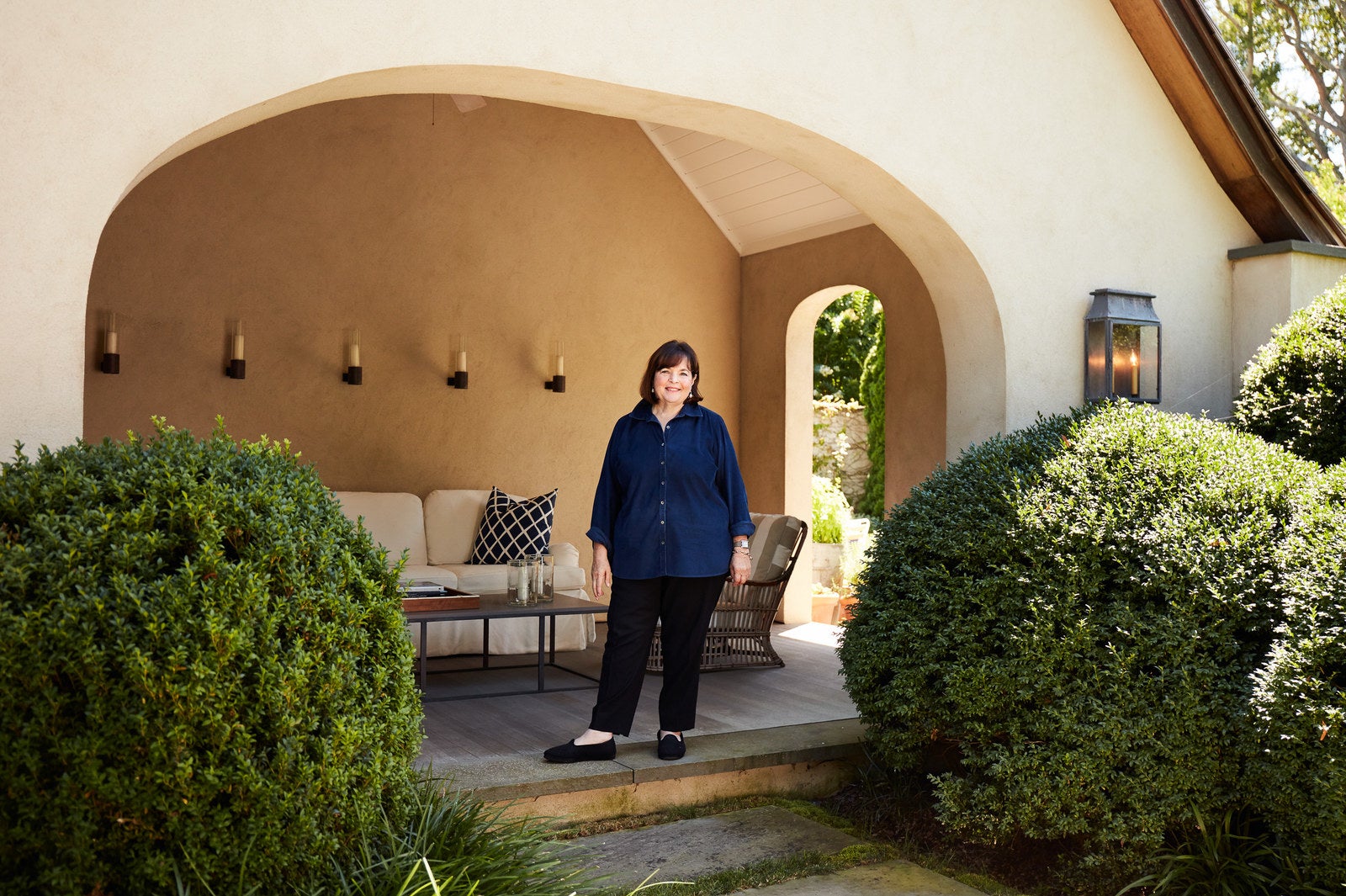I have been inside the barn, the barn, and I can tell you this: Inside, it was beautiful. I didn’t grow up with religious institutions, really, but there was something about the space that was, assuredly, holy. When I first entered it, I leaned back, mouth agape, and took in the ceilings, which were painted white and bisected by big, beautiful, old-looking beams, and there were little windows up near the top through which daylight streamed. The day was also beautiful. Eighties. Low humidity. The traffic going into East Hampton on this late August weekday morning was trucks, mostly pickup trucks, with saplings in their beds, and mowers.
The floor inside the kitchen side of the barn was blonde wood and also beautiful. I’d heard about them before, these floors. People who entered the barn were to be aware of the floors and very careful upon them. Crews, especially photo crews or video crews — and there are lots of crews that go in and out of the barn, given that they film the show there, and photograph the books — are instructed that if any equipment touches the floor, it should be placed upon blankets. Again, this morning, we were reminded of the blankets. They were beautiful too — white and cozy. I imagine to fall into them would be like leaping atop a Great Pyrenees.
She entered. Her shirt today was blue. Her hair had been blow-dried — she later told me it’s one of her luxuries, getting her hair blow-dried whenever she can. Her face had been done. She approached us, and to me it felt awkward and this made sense: I assume it must always be awkward, uncomfortable, bothersome even, having people in your beautiful barn, setting up their equipment on your beautiful blonde floor. Which isn’t to say she wasn’t gracious; she absolutely was. She approached me and the photo crew and shook each of our hands. She smiled. She was, obviously, nice.

She began to talk about the barn, which has been around for nine or so years now. Before that, they shot the show in her actual house. We could see it through the French windows across a green lawn, the iconic shingle-style farmhouse. She described how they’d film the show for six weeks at a time, two times a year, and during that period she and Jeffrey would be stuffed upstairs. She said if they’d gone on doing it that way, her husband was going to divorce her. She laughed and everyone else laughed and she clarified the divorce thing was a joke. Everybody nodded. Of course the idea of divorcing Jeffrey was a joke.
She talked about how she bought the land where the barn was built after eyeing it for years. When they finally bought it, she said, “Jeffrey said he thought I was going to build a little cottage. One day an enormous hole appeared!” She laughed and we laughed. She leaned back to admire the ceiling and so we all did too, looking again at the whiteness, the beams, the light.
But she had already pivoted, away, to the kitchen, assessing everything that her assistant had set out on the countertop — a magnificent countertop. There was a deep, wide sink in the center and two large cutting boards on each side of it. There were containers of wooden spoons and spatulas. Kale that her assistant had begun to prep. A bowl of eggs, a bowl of garlic, another of long shallots. Everything was tidy, and accessible, and abundant.
The object she had picked up first, though, was perhaps the least fancy-seeming thing in the space: It was the carafe from the white, well-worn coffeemaker. She flipped on the tap and filled it with water. It didn’t really seem to matter that this was the task she was doing. Object in hand, in her kitchen, she seemed to relax.
The coffeemaker was soon hissing, and a pitcher of milk had appeared by its side. Ina eyed and grabbed a silver tray from a shelf and set several white mugs on it. On the previously emailed schedule for the day was a 10:30 meeting, during which it was noted there would be coffee and scones. The scones had already been set out, and Ina Garten herself, it seemed, was the one making the coffee. That morning, I recall I felt pleasure that she made her own coffee. That she was a person just like you or me.
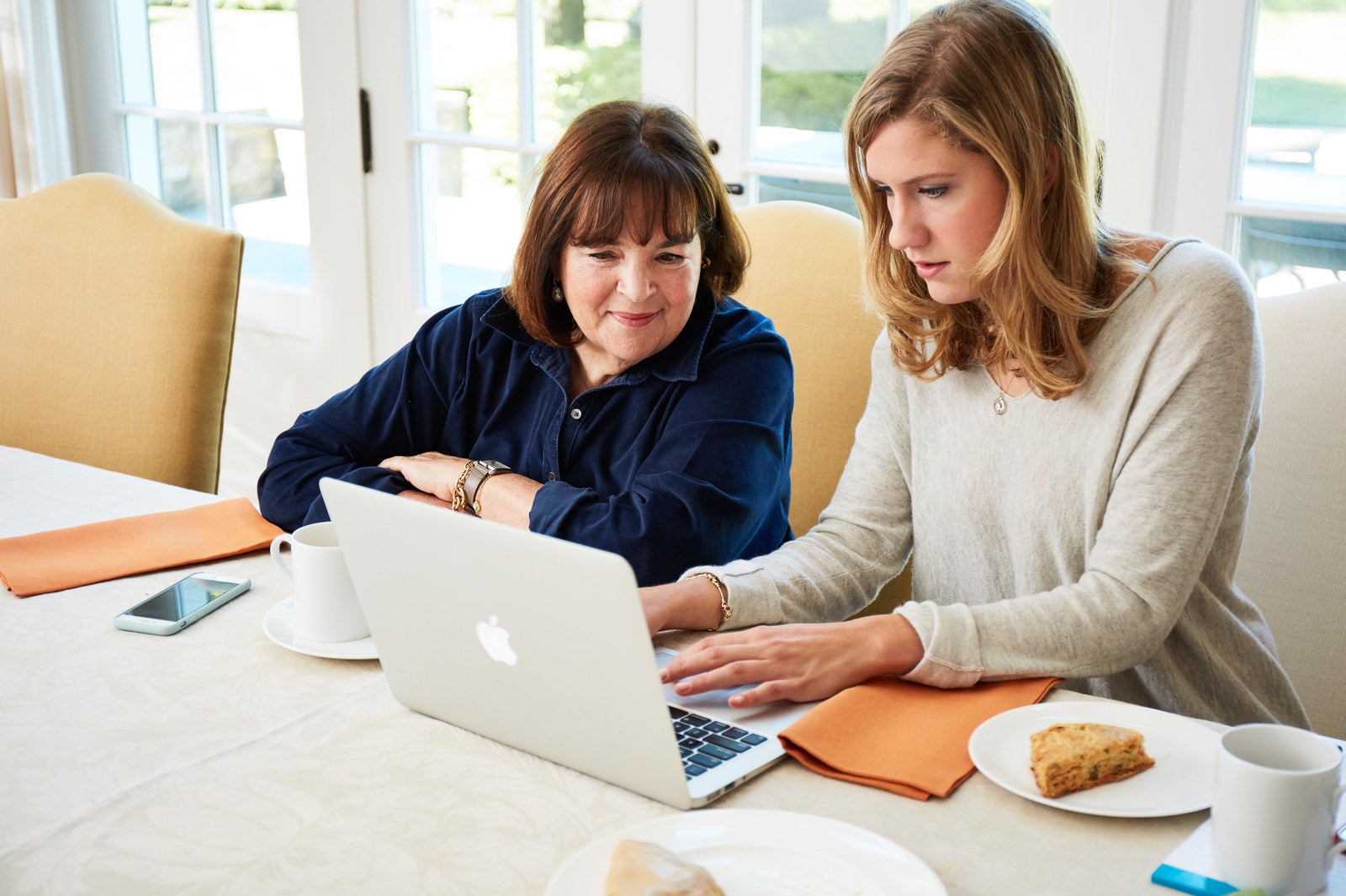
Ina Garten likes to say that what she likes about her life is that every day she wakes up and she gets to recipe-test with her assistants, whom she adores. There are two: The first, named Barbara, is closer to Ina’s own age (Ina is 68), and was out of town that day; the second, Lidey, is 25.
Lidey stood a head and a half taller than Ina. She was lanky and thin and blonde and immensely likable. She seemed green but very competent. Lidey, who’d been with Ina for three years, was not a professional chef; that wouldn’t be the point. Part of why Lidey was brought on, in fact, was because Barbara had worked with Ina for so many years, she’d gotten too good at cooking her recipes.
Today they were testing a Waldorf salad, one that will likely appear in Ina's 2018 book (not to be confused with her latest, Cooking for Jeffrey, which published in late October). This was, Ina and Lidey guessed aloud to each other, the fifth or sixth time they’d tested this Waldorf salad. Each woman set herself behind one of the great cutting boards and began prepping various ingredients, referencing a printout of the recipe.
Lidey was working with the frisée, and Ina, looking up, realized Lidey didn’t know how to properly prep it. She joined Lidey at her station. Taking the vegetable from her, Ina explained that the white core is hidden, that you have to turn the plant inside out before you cut out the root. She flipped it, like a ballerina removing a tutu over her head, and then, with a paring knife, de-stemmed it. “I know how to use frisée because I’ve done it before,” Ina said, “but Lidey hasn’t used it, so now I know what questions she has about frisée.”
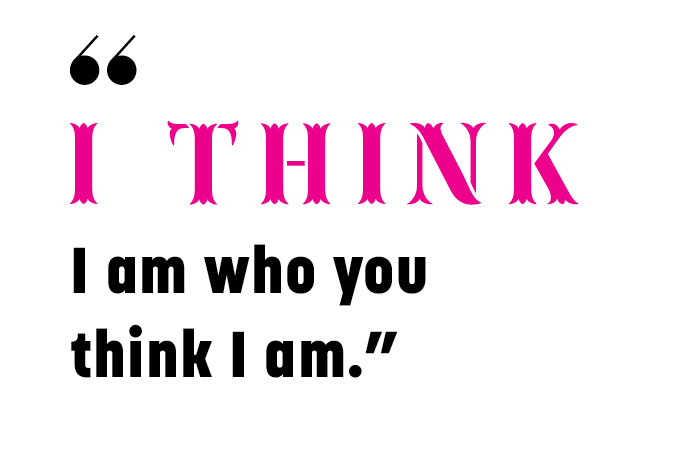
She took a Sharpie and made a note on the recipe page. Other notes were added as they worked: Ina, for example, would have never thought to tell the people at home to grate the apple only right before you’re going to serve the salad. Lidey set down the apple she’d begun grating, asked why, and Ina replied that it would brown. I knew this already. Perhaps Ina herself had taught me that fact; like a lot of people, I’ve spent untold hours of my life watching Ina Garten on television. But I held my tongue.
The CD player had gotten to Marvin Gaye’s “What’s Going On,” and Ina beckoned someone to turn up the music, saying, “I need tunes to cook.” Lidey toasted Marcona almonds and arranged bacon on a rack on a sheet pan. Ina weighed and then seasoned two chicken breasts and put them on another sheet pan. She spoke about how she had streamlined this recipe, so all three trays could go in the oven at the same temperature. Ina Garten’s recipes are never needlessly fussy. She doesn’t use techniques or ingredients she feels will alienate home cooks (as she likes to say, “It’s not some octopus eyeballs with seafoam”). She focuses on simple, quality ingredients, and strives to make everything as flavorful as possible. Her own recipe books, the dog-eared row of them, were in her kitchen. I later remarked to her how lovely that was to see, that she cooked from her own books, and she answered that of course she does. “But remember, I’ve written a thousand recipes," she said. "Maybe 850 recipes. I can’t possibly know how much thyme goes into each one. I follow the recipe every single time I make a recipe. I don’t just throw things in.” Ina Garten uses her recipes for the same reason a lot of us do: They work.
Before she departed the room, Ina pointed to three white timers, indicating to Lidey: chicken, bacon, nuts. “How bad could this be?” she asked, and I felt my pulse quicken at hearing an actual quintessential Ina Garten rhetorical question in the flesh. Ina then walked away, telling Lidey she’d like her to make the eggs by herself, to make sure the instructions make sense.
Lidey had been a senior at Bowdoin in 2013 when she’d dreamed up this idea of working for Ina Garten. A good friend’s father is Ina’s attorney. We talked about the Hamptons, about what it’s like living there as a young person — she has a cottage nearby — especially during the 10 months of the year when there aren’t tourists in town. She got a Welsh terrier she named Winkie, which helps, she said. She took up bridge. We talked about the biggest things she’d learned since coming to work for Ina, like having an oven thermometer, like paying attention to timers. Panic flashed through her blue eyes as she said this, and she shot a quick look at the white row of them.
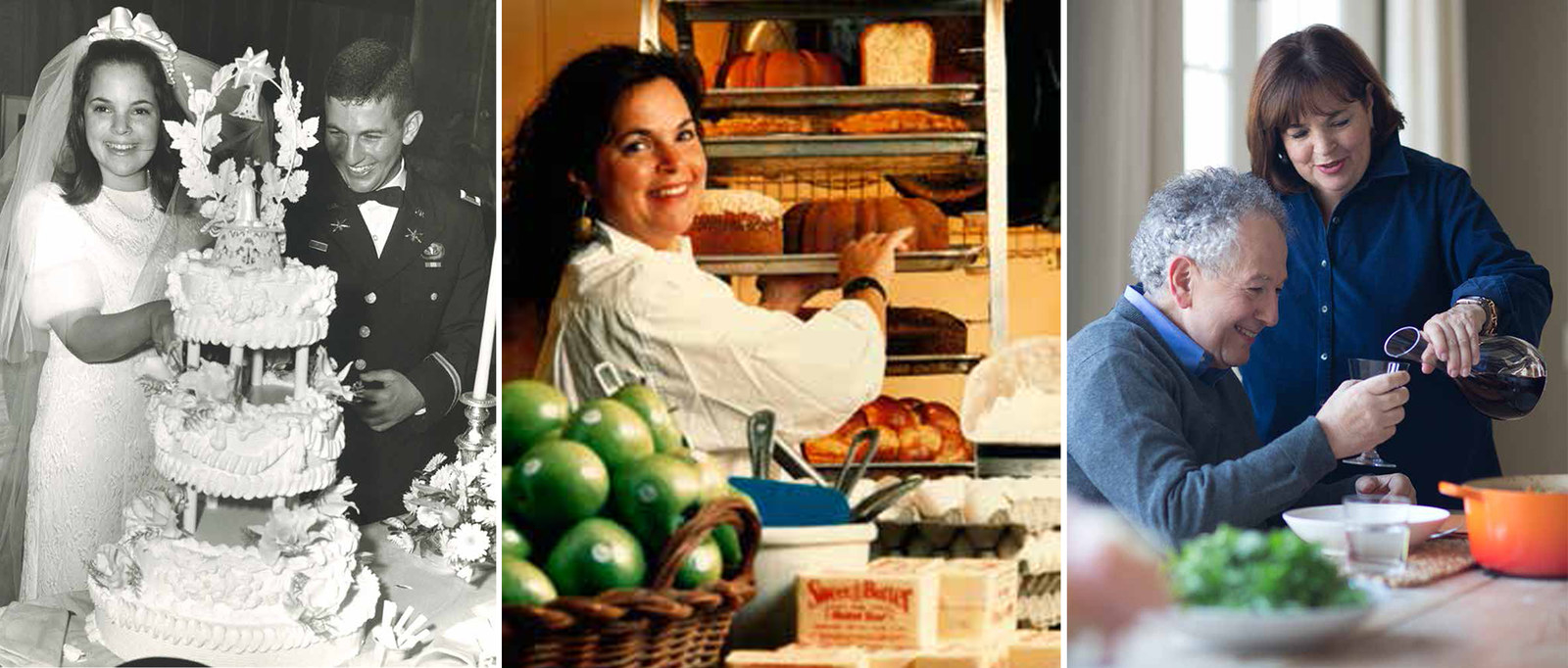
The other main room in the barn resembled a living room. The floor was stone and there was a great hearth. Again, white fluffy rugs were about. On each wall was an enormous library of books, almost entirely cookbooks. They were orderly, but they also seemed handled often. Post-its poked out of their pages.
In the middle of the room were two puffy orange sofas facing each other, with a puffy orange ottoman between them. Ina figured out which sofa I should sit on and chose a wooden chair for herself. It looked antique, delicate and unusual — its back tall and tapered. When I asked where it was from, she said she believed Belgium. She remarked about how comfortable it was and implored me to sit on it. She rose and I got up and sat on it. “Isn’t it comfortable?” she said, and I had to agree: For an upright old wooden chair it was astonishingly comfortable. We returned to our places and she put her feet up on the ottoman. She wore little slippers.
The first thing we talked about was how loyal her employees tend to be — how her other assistant Barbara worked for her for years, and how a bunch of Barbara’s family worked for her too, back when she had the store. (I later asked to interview Barbara and was declined.) “You’re loyal to people,” I said. She replied, “Good people. Good people. If you’re not really good, you’re off the bus.”
And then we talked about Cooking for Jeffrey. It is her 10th cookbook, and, unlike her previous ones, it incorporates many photos of the two of them, and single-page essays about phases in their marriage, steps in a myth many fans have memorized: Ina met Jeffrey when she was very young, just 16. She was visiting her brother at Dartmouth College, walking across campus. He saw her, figured out who she was, and got in touch. During their courtship she mailed him brownies. They married when she was 20. There’s a photo of them on their wedding day at the beginning of the book; they’re cherubic. They lived in North Carolina. He was in the Army and served in the Vietnam War. It was during a camping trip one summer in Europe — especially in France — when Ina really began to fall in love with food, with cooking from quality ingredients. Back home, she bought Julia Child’s book and started cooking through it.
They lived in DC. He worked in the White House; so did she, for four years, drafting policy papers on nuclear energy out of the Office of Management and Budget. It was a job she described as exciting the first year, and less so the second when she realized she was working on all the same papers again, and even less so the third. She was nearly 30 and she realized she wanted something else. That’s when she saw the listing in the New York Times for the Barefoot Contessa food store for sale in Westhampton Beach — a place she’d never been — and they drove out and saw the 400-square-foot space. For fun, as she tells it, they put in a low offer (she’d been renovating and selling houses some in DC), and to their surprise, the owner called the next day and said it was hers. (“O.M.G.,” she wrote in Cooking for Jeffrey, “I just bought a business!”)
She ran it for 20 years — eventually moving to a larger East Hampton location. In 1999, she sold it to the chef and the manager, and kept an office above the store as she figured out what to do next. She considered the stock market. She considered real estate. While she passed the time, she wrote a cookbook — something Jeffrey suggested she do — called The Barefoot Contessa Cookbook. It was a best-seller, and it was followed by another nine best-sellers. (Cooking for Jeffrey is currently topping the New York Times list.) There are 11 million copies of her books in print, and then of course there’s the Barefoot Contessa television show, which has aired on Food Network since 2002. She has over a million followers on Facebook and is approaching that on Instagram. When we talked through her biography, I asked Ina if, when she wrote that first book, she ever imagined she’d become a celebrity.
“Well, I don’t know that I am,” she said.
“You definitely are,” I said.
“I never imagined that I’d be writing 10 cookbooks, for sure.”
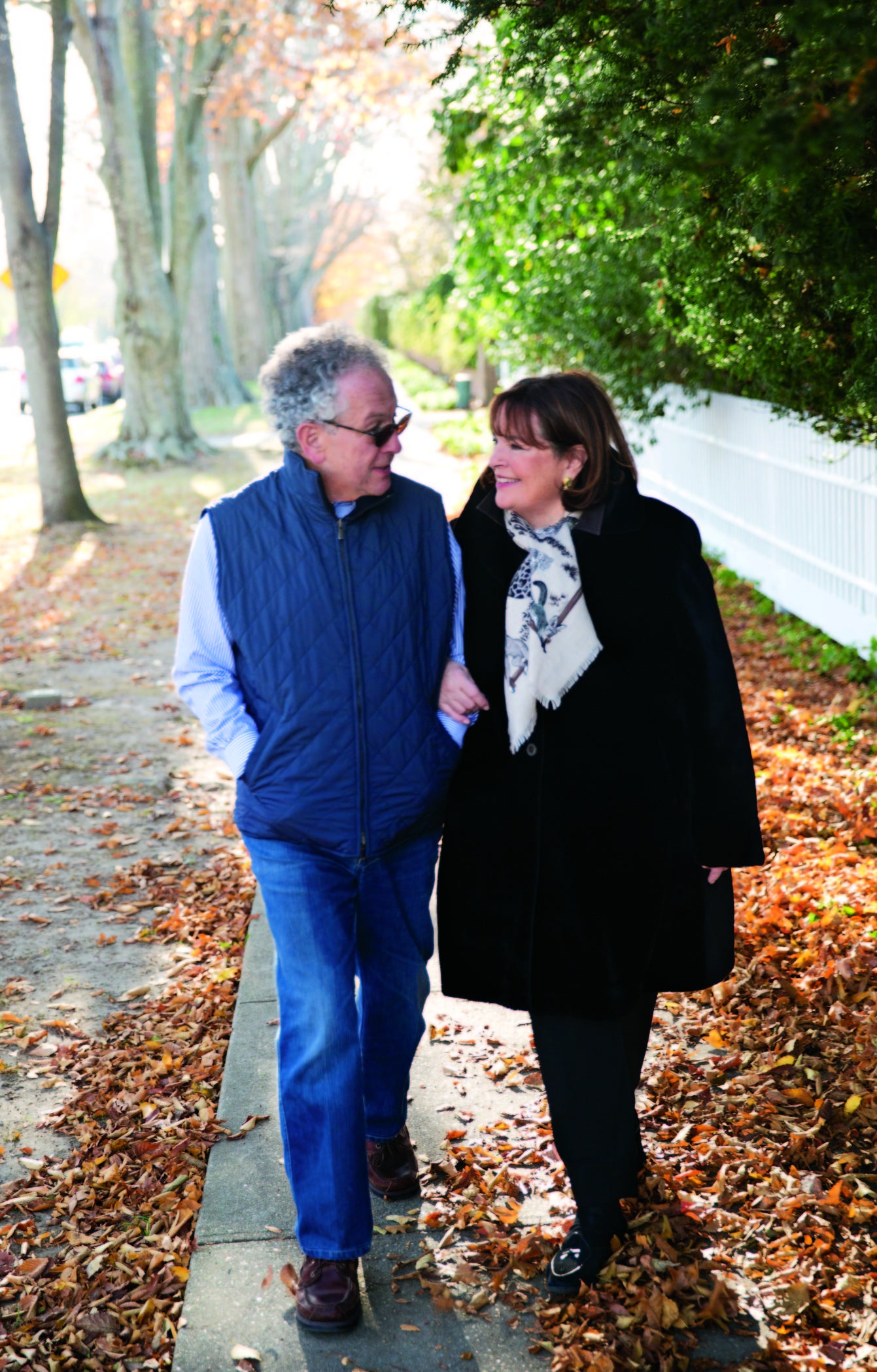
I asked Ina what had inspired her to make Cooking for Jeffrey more personal than her previous cookbooks. That first one was about the store, and then there were books about things like parties, going back to basics, dining family-style, making things ahead, Paris, simplicity.
“It’s such a love letter,” I remarked.
“It is. I meant it that way,” she said.
“How did you decide to turn more that way?”
“I think he’s remarkable,” she said. “He’s a really important part of my career. How many people get to be married to the dean of the business school at Yale who gives you such good advice but doesn’t impose himself on you?” She described how he’d come to her on occasion with three ideas of things she could do, and before he could even describe all of them, she’d be off and running with the first. “He’s an incredibly kind and generous guy,” she said. I had already asked Ina’s publicists if I could interview Jeffrey but was turned down. Fans won’t be surprised that he wasn’t home in East Hampton when I was there. Much of the copy in her books and action on the show is focused around the activity of making Jeffrey dinner when he gets home from New Haven (or wherever) on Friday nights. That, or cooking for her (occasionally gay male) neighbors, which perhaps contributes to her considerable number of fans who are gay men.
A profile of Jeffrey Garten in Johns Hopkins Magazine this spring titled “Jeffrey Garten Is a Financier, Academic, and Author — and Yes, He's Married to the Barefoot Contessa” described him:
He knows a thing or two about world affairs. He's a former U.S. Army paratrooper who's held senior positions in the Nixon, Ford, Carter, and Clinton administrations. He first wrote reports on developing countries for then Secretary of State Henry Kissinger, and he later represented U.S. economic interests in emerging markets like India, Brazil, and China. As a vice president and later managing director at Lehman Brothers, he specialized in debt restructuring in Latin America and built up Lehman's investment banking business in Asia, which involved restructuring some of the world's largest shipping companies. To complete his career trifecta, Garten entered academia in the mid-1990s and managed to turn around the moribund business school at Yale, where he still teaches. He's also a businessman who co-founded an international consulting firm.
His sixth book was published this year by HarperCollins. It’s called From Silk to Silicon: The Story of Globalization Through Ten Extraordinary Lives. Those lives include Genghis Khan, John D. Rockefeller, Margaret Thatcher, and Andrew Grove, a Hungarian Jew who fled Nazi oppression and immigrated to the US and became the CEO of Intel. (I later asked Ina whether her husband was in the CIA — something another journalist had joked about before. “No, of course he isn’t,” she said. “Jeffrey’s had such extraordinary jobs that I think people wonder how he got there. Funny explanation is ‘Everybody knows he’s in the CIA.’ And if he is I don’t know about it.”)
I asked Ina if she'd asked Jeffrey’s permission to write a book about the two of them, about their lives.
“He’s the most supportive person I’ve ever known in my life,” she answered. “I don’t think I ever asked his opinion. I probably just said, ‘This is the next book.’”
“Has he read it and such? Has he seen it?” I asked. I had an advance copy of it and was thinking specifically of a page toward the end called “Jeffrey’s all-time favorite dinners."
“I don’t think he has yet,” she said. “I think he’ll wait until the book comes out.”
I asked how she starts a book, and she said each begins with her sitting down and thinking of, say, 75 or 100 recipes — things she’d like to eat. And it’ll be flexible. “I’ll go to a restaurant and say, ‘Oh, that’s really interesting, figs and prosciutto. I think I’ll make a pizza with figs and prosciutto,’’’ she explained. “I’ll read everything that I can from people whose work that I admire about pizza with figs and prosciutto, and then I’ll put them all away and make my own.” As she said this, the walls on either side of us, all those cookbooks, seemed to lean toward us, as if wondering who were the ones she respected.
She recalled that before she wrote the first book, she'd thought her publisher should hire a writer — but they insisted she do it. She'd thought it would be a really solitary process, making cookbooks, but it’s not; it’s very collaborative. Photo shoots are fun. And she doesn’t make the food look better for pictures; “no motor oil” is the phrase I’ve heard her say. I asked how she found writing itself.
“It’s pure torture. It’s never gotten easier. It’s just excruciating.”
We talked about Instagram. Lidey was the one who convinced her to do it, actually by just setting up an account and showing Ina what it would look like. That’s how Ina came around, and she now posts things as well (though sometimes because Lidey prompts her to). I asked Ina if she looked at Instagram herself.
“It’s the first thing that I do when I wake up in the morning,” she answered.
“Who do you follow?” I asked.
“Who do I follow?” She sort of laughed. “Taylor Swift?” I’d read before that she and Taylor Swift were friends of some kind.
“Are you internet friends or real-life friends?” I asked.
“I’ve had the unbelievable good fortune of meeting her a few times,” Ina said. “I think there’s nobody I admire more. She’s an extraordinarily talented, creative, principled woman. I just adore her.” She talked about how they met, which was at a Food Network photo shoot where celebrities got to pair up with their favorite Food Network stars, and Ina was excited Taylor chose her. “It was really sweet. She said, ‘I follow very few people, and you’re one of them.’ I said, ‘I follow very few people, and you’re one of them.’”
We talked about the others she followed — a friend who’s a stylist and photographer. Accounts that post paintings — old paintings, new paintings. A landscape architect who posts photos of gardens from around the world.
“Beautiful things,” I remarked.
“I like to see beautiful things,” she said. She added that she followed National Geographic and Danny Meyer. “I follow anything Danny Meyer does because I adore Danny Meyer.”
“Family and friends as well?” I asked.
“Interesting,” she said. “I follow winkiethewelsh and lideylikes.”
We talked about how else she spends her time online: She reads the New York Times. She reads New Yorker stories sometimes there, but prefers magazines in print. Books she reads both in print and digitally.

I asked about something I’d always found intriguing: When Ina and Jeffrey were living briefly in North Carolina while he was still in the Army, she had gotten her pilot’s license. I asked how she thought to do that: “My roommate in college was an aerospace engineer. She had a pilot’s license. So I always thought it was very cool.” She repeated a detail I’d read before, which was that back then, in the ’70s, they had to work to find an instructor in that state willing to teach a woman.
“What do you feel that women of your generation understand that maybe those of mine don’t?” I asked her.
“How different it was,” she said.
“How so?” I said.
“I grew up in an era when I wanted to fly an airplane and they wouldn’t find a woman who’d teach women to fly,” she answered. “I think women in your generation don’t realize how different it is now than it was then. Starting with a woman being a candidate for president.”
“How does that make you feel?” I asked her.
“It’s great. To me she’s a person who’s a candidate for president who happens to be a woman.”
I'd been thinking a lot about the similarities between Ina and Hillary, and I mentioned to Ina that they were born the same year. “The scrutiny she gets that’s so much higher than it’d be for a male candidate of the equivalent resume,” I said.
“Of course, of course,” she said.
I asked if she felt she was scrutinized more than a powerful man in her position would be, and she answered, “I work for myself, so it’s different. But I do know that there is a group of men — I don’t want to make a generalization — that don’t like successful women. That is changing, but it’s changing slowly. She has been incredibly tough standing up to that. And I admire her tenacity and her drive. And her interest. I think she’s just remarkable. Because nobody that’s not that strong could have put up with all that she’s put up with this year.” I asked if she wanted to say anything on record about Donald Trump and she declined.
The room’s lighting was soft. On a table by the door with a lamp sat a single photograph in a black frame, of Jeffrey, wearing sunglasses, smiling. There was a well-tended ficus tree and a sculpture. Outside the French windows was a smaller lawn, with a hedge and a large gurgling fountain. Ina wondered aloud whether lunch shouldn’t be served out there, but Lidey, passing through, informed Ina that it wasn’t shady outside. Ina resolved that lunch would be served inside. I had noticed Ina’s CDs by her cookbooks, a Taylor Swift album displayed. Before long, it was Taylor’s voice echoing through the barn.

Ina often says that those who come to eat with her are her actual friends. Today’s two guests certainly seemed friendly with her, or at least very glad for her hospitality, but they also were here on business. They’d done some shooting for Ina, time lapses of recipes set to a jaunty tune everyone seemed a bit sick of, ones that were later released on Instagram. Ina had already seen the videos, and as they began to play, it was clear she was pleased, generally, with the edits.
A video then played in which Ina appeared more, and a sound leapt from her, a displeased sound, when she saw herself walking through frame. (I later asked her about something I’d heard, which is that she’s never seen her own show, that she doesn’t watch it at all. “Oh god,” she said, seeming to shudder. “Have you ever?” I asked, and again she sort of viscerally reacted to the idea of it. “Oh no,” she said. “Why?” I asked. “Oh, I just think if I had to watch the show, I’d never do it again. I just don’t understand it. I’m glad people like it. But I just can’t. Watching myself on TV.”)
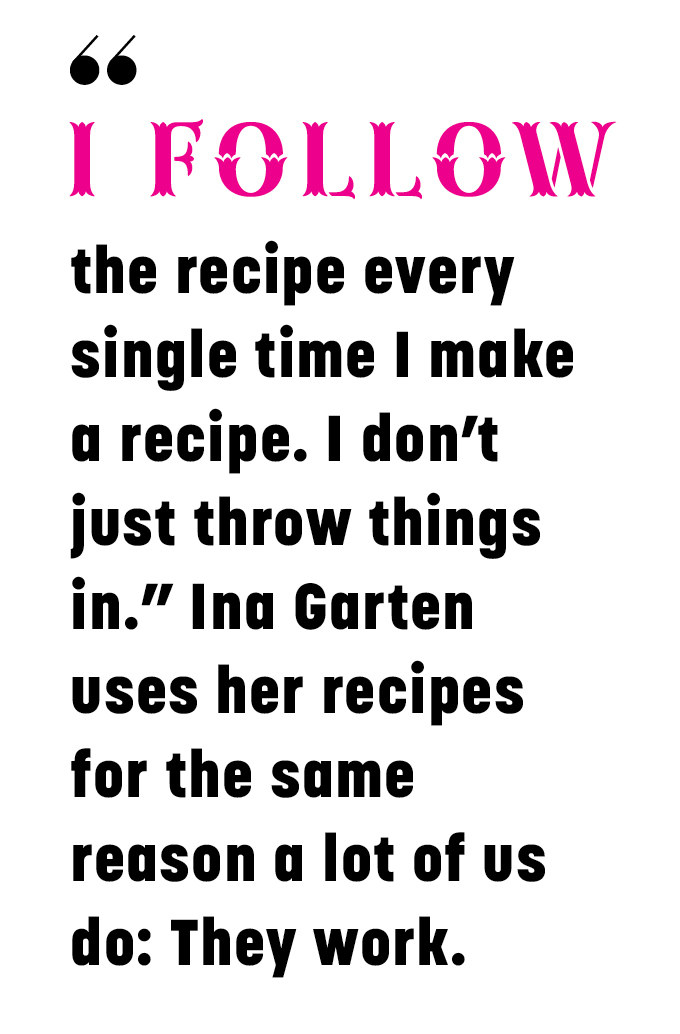
The lunch guests next showed slightly longer videos, ones that included Ina talking. Ina stood, placing her hands over her hair and ears, and walked back to the kitchen. The rest of us continued sitting, tentatively, watching the videos that were still being screened. Ina began moving dishes from the sink to the dishwasher and running the disposal.
Jeffrey appeared in a few of the videos, in one boasting that he often meets people who introduce themselves as her greatest fan and he says no, he is her number one fan. In another, she and Jeffrey eat a panna cotta topped with caramel and rum. As he removes the spoon from his lips, Jeffrey says that it was the best dessert he’s ever had. It sounded like a totally genuine statement.
The Waldorf salad was served for lunch, on placemats, which Ina at first decided against, and then decided in favor of. Lidey quickly set those, along with white plates and napkins and forks, and produced chilled bottles of Pellegrino. Everyone paused once the table and the salad had been set, realizing Ina probably had an opinion about where everybody should sit. Ina pointed to each chair and said a name. She put herself in the center, facing away from the kitchen, toward the windows and her home, the green lawn, the lavender wafting in the breeze. A man appeared now and again on a mower. The meal was convivial. There was laughter. It was off the record.
Afterward, Ina realized aloud that she didn’t have any dessert planned. In the kitchen, she removed four panna cottas from the fridge. She heated caramel sauce in an instant on the stove and atop it splashed some rum. She sprinkled a little sea salt on each and put them into our hands.
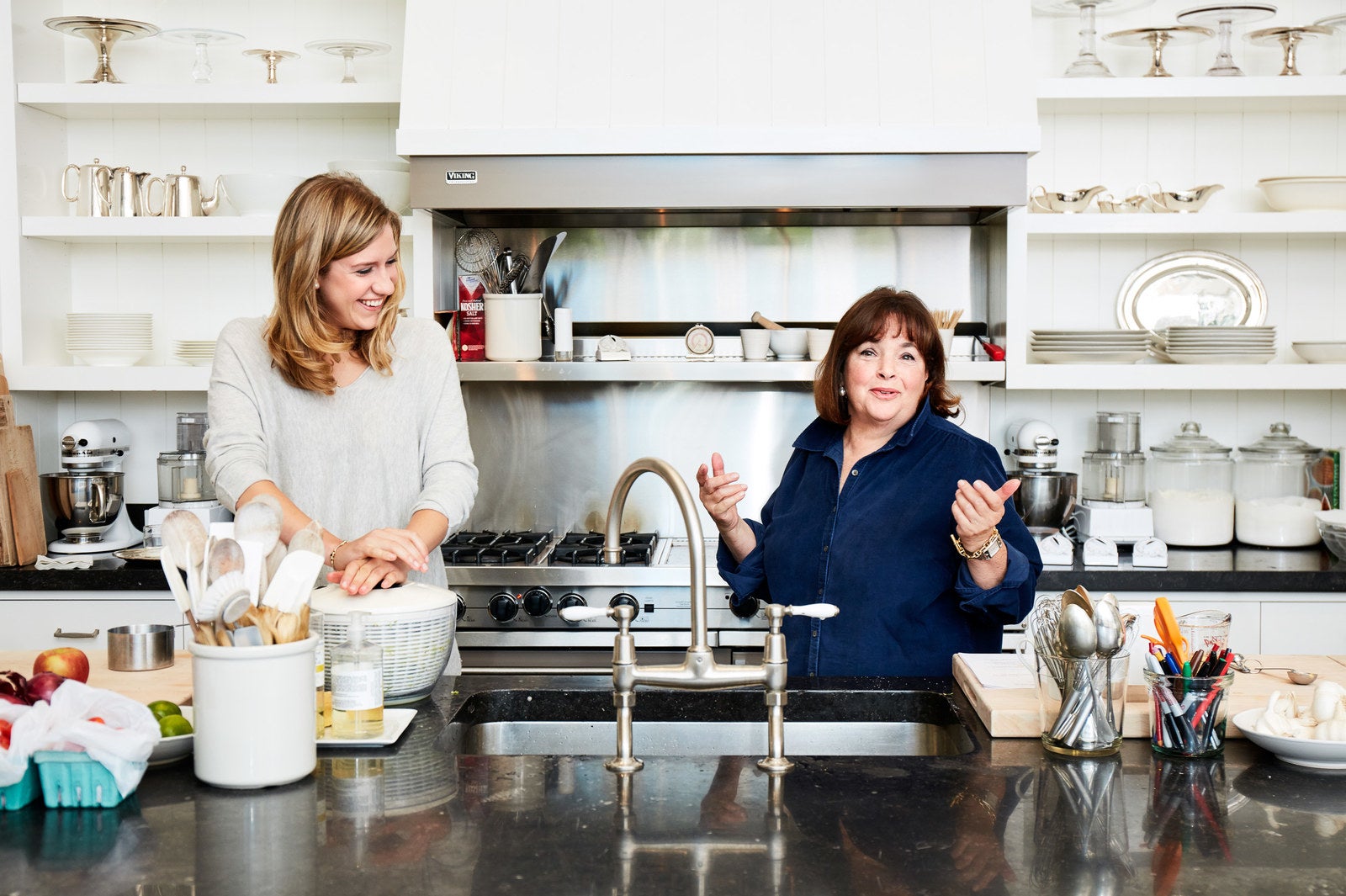
It’s not unusual, I don’t think, to meet someone famous and realize that she is different from what you’d expected she’d be. I puzzled for days and weeks after I drove away from East Hampton over what exactly had been different about Ina Garten than whatever my expectations had been. One phrase she’d said played over and over in my head. I had been asking her about what parts of her life she chooses to let the public see and what parts she doesn’t. She said she doesn’t think of it that way. “I think I am who you think I am,” she said. I wondered who exactly I thought Ina Garten was. She didn’t consider herself a celebrity; she considered herself a cookbook author — that was where her energy actually went. And so I cooked as much as I could of Cooking for Jeffrey.
I made the maple-roasted carrot salad (“This may be my favorite salad ever,” Ina had commented in the recipe’s notes); it was delicious. I made the also delicious kale salad with pancetta and pecorino. (“Okay,” Ina had written, “I know there is a rebellion against kale going on. I’m not suggesting you eat it every day but it has great flavor and it’s also so good for you.”) Feeling glamorous, I made the arugula with prosciutto and burrata and served it for lunch, outside, on the terrace. I made the roast chicken with radishes — an utter revelation. Ina noted that she’d once seen a French woman serve roast chicken with radishes decades ago and the idea had stayed with her ever since. I honestly had no idea a radish could be roasted, let alone taste as exceptional as these ones now did. My Jeffrey, like Ina’s Jeffrey, really loves chicken, and he was really all right with living this way.
On a Friday, I made my Jeffrey the challah with saffron. Ina described how challah was one of the first things she cooked Jeffrey when they were first married. I admittedly might have messed up when I was counting the number of cups of flour I put into the bowl, and the thing came out rather gargantuan and heavy, though still tasty enough. My Jeffrey came home late and had to be on the phone for work for a long while anyway. As he talked, we sat at the counter, cutting off and stuffing into our mouths slab after slab and drinking a bottle of cheap red wine.
Over Labor Day weekend, I made us the orecchiette with farm stand pasta sauce and the fresh peach cobbler, both of which included the (I think) obnoxious step of having to plunge orbs into boiling water and then an ice bath, and imperfectly peel away their skins. Both were good, if a lot of work. “I freeze it in quarts and serve it all winter,” Ina wrote of the tomato sauce, so I did the same. The next morning I made the zucchini and leek frittata, which was garnished with zucchini flowers. I tried to imagine keeping this up, being the kind of person who placed zucchini flowers on top of a frittata.
For a dinner party, I made herb-and-apple bread pudding, sautéed shredded Brussels sprouts, and two of the (divine) skillet-roasted lemon chickens. For dessert, I made her raspberry roasted applesauce, a spectacular concoction that involved putting lots of specific kinds of apples and two packages of raspberries with a big blob of butter and cinnamon and brown sugar in a Dutch oven for a while, and then whisking the entire thing pink. “A scoop of cold vanilla ice cream melting into a bowl of warm homemade applesauce is my idea of heaven,” she’d written. And it really was.

I had people over to watch the final presidential debate, producing a spread of butternut squash hummus and English oat crackers — “I made these crackers from scratch!” I squawked — and the Parmesan and chipotle popcorn. I then left town for the weekend and my Jeffrey texted that he was subsisting almost entirely on hummus and oat crackers and he couldn’t be happier.
I made the chipotle smashed sweet potatoes, I made the brisket with onions and leeks, I made a bunch of the roasted broccolini. I made the astonishingly good crusty baked shells and cauliflower, a dish that called for her homemade ricotta. I found that ricotta, as Ina had promised, is very simple to make. I made the fig and goat cheese bruschetta. “It may be the best thing I’ve ever made!” Ina had written. I wasn’t as big a fan of this one, which I admitted to Ina when we spoke again on the phone. The recipe had called for what felt like a lot of sugar to me. I sheepishly told Ina I'm not a huge sweets person, but added that a friend who’d tried the dish with me, someone who is, had raved about it. “The thing about that is the vanilla has a bitter taste to it, so the vanilla really takes down the flavor of the sugar and the fig,” she said, and I nodded into the phone, even if I didn’t agree. During that conversation, I asked Ina what she ate when she went on the road. “You can find apples and raisins and nuts,” she said, adding, “Every hotel has a good chef salad.” She mentioned she was traveling the next day, to Washington, DC, for an event “Mrs. Obama” was hosting — during which they taped an hourlong episode for the show’s new season.
I tried, when cooking these recipes, to best model Ina's behavior. I measured carefully. I weighed things, having found a scale my Jeffrey owned in our kitchen cabinet. I bought an oven thermometer and observed how cold my oven apparently always was. Cooking the recipes surely became one of the ways I dealt with the election’s stress.
As I did, I thought about the Contessa brand, and what it promotes as virtuous — comfort, simplicity, quality. I thought a lot about Jeffrey, about the adoration of Jeffrey, and what that is all about. “It adds to his mystique,” she said when I asked about the attention he attracts. “I think he’s extraordinary. He’s an extraordinary man and he deserves all of the praise anybody could give him.”
I thought a lot about this particular kind of feminism in which women can be successful in our own right, but are more successful when we’re paired with, and serving, powerful men. Like a lot of women in this country, I had supposed throughout my lifetime that we were marching forever toward greater gender equality. As I cooked these recipes this fall, I did not know that I was living through what might have been a high-water mark.
I thought about the whiteness of her sensibility — her heeding, generally, to European and American culinary traditions, albeit with the occasional recipe for vegetable sushi, or roasted salmon tacos. (In East Hampton, we talked about Thailand — she’d stayed in Bangkok one summer when Jeffrey was in the Army. I’d asked whether she liked the food. “I’m not that crazy — I dunno,” she said. “I didn’t know to understand Thai food at the time. Not that I do now. It was fun. We had fun.”)
I thought a lot, too, about who her recipes are for — which is to say, who they are accessible to. I wondered a lot about people who loved Ina’s recipes and could not afford, say, syrupy aged balsamic vinegar, saffron threads, dry sherry. Ina often says that her recipes are made of “ingredients you can get at a grocery store,” and there is a question as to who “you” is in a sentence like this, and also which grocery store.
Through these months, there was one recipe in the book that I found myself avoiding, even though it coursed through so many of her others. It was for homemade chicken stock, and it appears in all the books except the first one and Parties! I’d read through all 10 books in order, marveling at how consistent everything was through the 17 years she’s published them — the copy, the photos, her tastes.
I’ve always considered chicken stock to be freebie food that you make from boiling carcasses and vegetable leavings. In what I felt were lean times, I’ve certainly filled old yogurt containers with stock and put them in my freezer and felt a sense of pride. But Ina’s stock is something else. It calls for three 5-pound roasting chickens, and then celery and parsnips and onions and prescriptive numbers of sprigs of dill and parsley and thyme. The chickens alone would run me $30, and then there was the problem that I didn’t have a pot as large the 16- to 20-quart one she’d called for. I read through the hundreds of five-star reviews of the recipe on the Food Network site. Some home cooks also admitted to being disturbed by its cost, explaining the ways they modified it to make it more affordable. Many insisted they followed it to the letter. I tried making a batch that was a third of the size, using only one chicken. I felt rancid guilt as I tossed an entire besotted carcass — all taste boiled out of it, its texture tough — into the trash. I didn’t even have the heart to taste the pathetic amount of genuine Ina Garten stock I made from it; I set the two containers in my freezer.
And then the day of the election came. Taylor Swift, who’d been silent on the topic until that point, had the most-liked Instagram that day — one with an American flag emoji, and a command to vote. And that day, of course, white people — including a majority of the white women who voted — elected Donald Trump president. During the week that followed, I wrote to Ina’s publicist asking for 15 more minutes on the phone. I explained that we’d chatted plenty about the election and, given this outcome, I was curious to hear her thoughts about how people should proceed, especially as many will return home, and sit around Thanksgiving tables, perhaps over Ina Garten recipes, and face relatives who voted the other way. Her publicist said Ina was on a book tour. I pushed back. I got my answer: “Ina prefers not to comment about the election, and we ask that there is no reference to her having been asked.”
Though it was November, the world remained eerily warm. I nonetheless defrosted the farm stand pasta sauce and served it atop orecchiette. I ate it with a friend — who’s queer and Muslim — and we laughed, in a way, about the unknown to come. And it’s true that there is a comfort to food such as this, to meals such as these. And it’s true, I guess, that we should find comfort in such meals while we can. It’s also true that, in this time especially, it is more tempting and perhaps more insidious than ever to hide in bowls of steaming food, or on Instagram, in spaces and images unmarred by whatever is next to come.
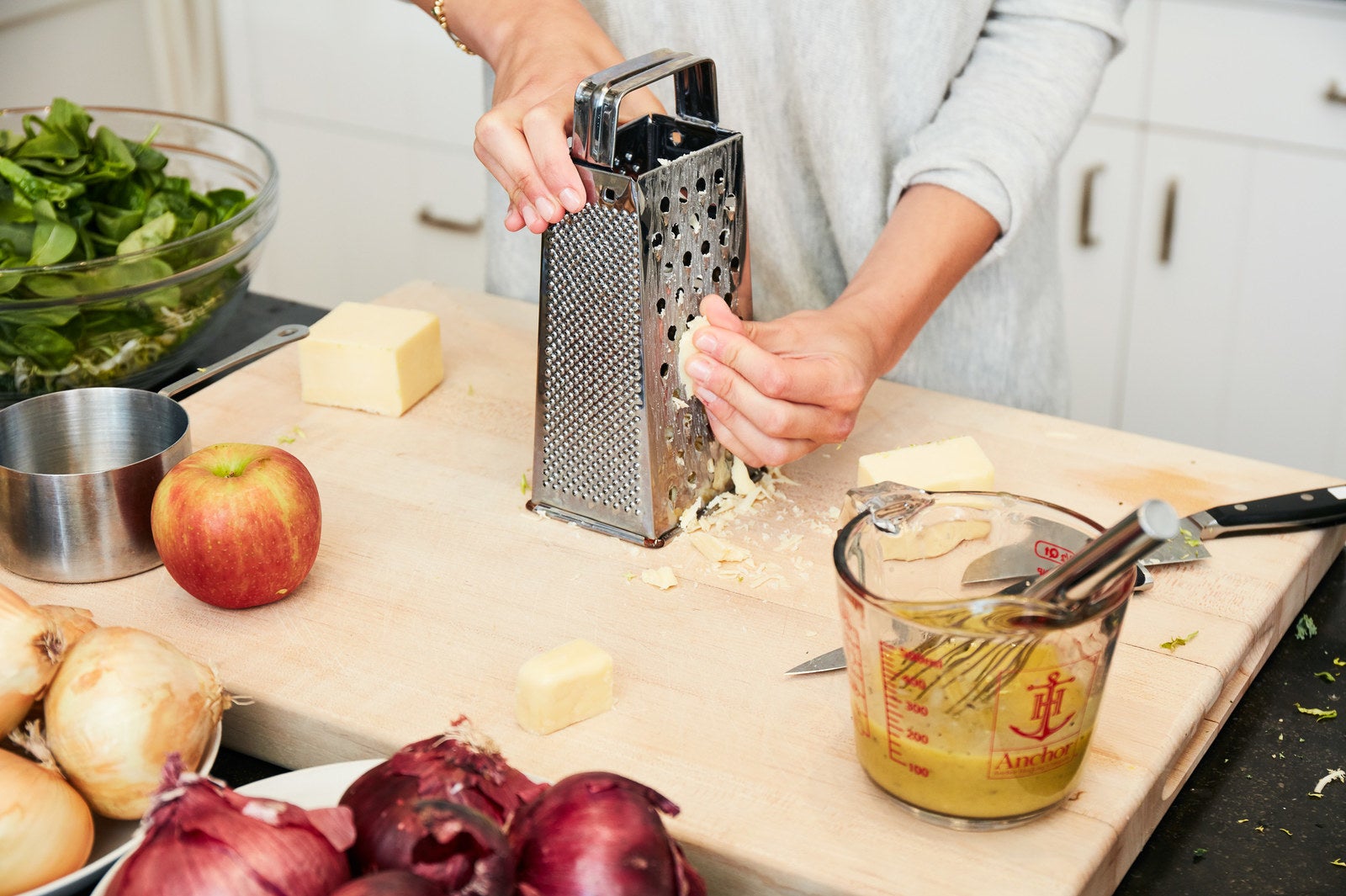
She was born Ina Rosenberg, in Flatbush, Brooklyn. Her grandparents emigrated, she’d told me, from “Eastern Europe. Ukraine, Poland.” They came to America and eventually owned a candy store. When Ina was 5, her family moved to Connecticut. Her father was a doctor. Her mother did all the cooking; it was the ’50s. “You had lamb chops on Tuesday and chicken on Thursday,” Ina said of the food in her childhood home. She wasn’t allowed in the kitchen, she said; she was told to study.
I asked that day back in August whether her family had been observant.
“Mildly,” she said. “Kind of — we observed the holidays and we had Passover and stuff like that.”
I asked her whether she, as a child, believed in God, or whatever parts of Judaism she’d been exposed to.
“I don’t know how to answer that. I’m Jewish. I’m very happy to be Jewish. But my life doesn’t revolve around it. I think culturally more than religiously.”
On the recipe for kasha varnishkes with wild mushrooms in the new book, Ina had written, “Jeffrey loves when I make traditional Jewish dishes.” I tried to ask about that — about whether it was meaningful to preserve this cuisine. “I think I do that with Italian things and French things,” she said.
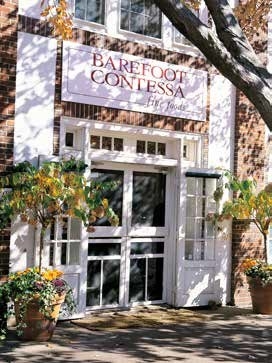
Ina had brought up her grandparents’ candy store in relation to the moment in her own biography when she bought the store called the Barefoot Contessa all those decades ago. She recalled how her parents had reacted to that news: “When I left the White House to buy what they thought of as a grocery store, they were like, 'Really? It’s going in the wrong direction?'” The store already bore that name; its previous owner had liked the 1954 film, which stars Humphrey Bogart and Ava Gardner. It’s always been curious to me that the Barefoot Contessa name, the one attached to her brand and her books and her show, doesn’t actually have anything to do with her. It sounds vaguely Italian. It has a whimsy. Plenty of people I’ve chatted with thought that was her name. That she was the Contessa. I’d heard her say that she hadn’t ever seen the movie, though in late October, when I saw her interviewed on stage by Tina Fey in Brooklyn, she said she finally had. “I actually saw it quite recently,” she said. “It’s quite a dark movie.”
The house that night was packed. Voracious. I saw Lidey in the crowd before we entered, and a grinning young man recognized her and asked for a photo. Two middle-aged women walking to their seats by me clutched each other and squealed, “I’m so excited!”
Ina was in purple that evening, Tina in blue, and the house absolutely lost it when they emerged. Tina was, clearly, beyond honored to be sharing the stage with Ina Garten. “I’ve learned so much from trying to cook your recipes,” she said right off. “I’ve never had as much of a visceral freak-out from people in my life as when they heard I was doing this. You are more popular than Tom Hanks and Blue Ivy combined.” Ina beamed and laughed nervously, and the crowd went wild.
Ina had previously explained to me that she can’t fathom standing alone on a stage and just speaking to people. Once, she said, she had to speak by herself for 90 seconds: “I was terrified. I rehearsed it for weeks.” But then she had been talking to her friend Mel Brooks, who told her he was going to be interviewed on a stage by someone, and she thought that was a fabulous idea. That’s how she’s done it since: 90 minutes on a stage — 60 minutes of interviewing, and then 30 of audience questions. She used to do signings but stopped those because, she felt, people would wait for three hours and then get only 15 seconds with her. “And the second thing that happened is in that 15 seconds they were turned around to take a selfie. They didn’t even have a conversation with me.” This new arrangement — an interview, pre-signed books for sale in the lobby — was more satisfying for everyone, she thought.
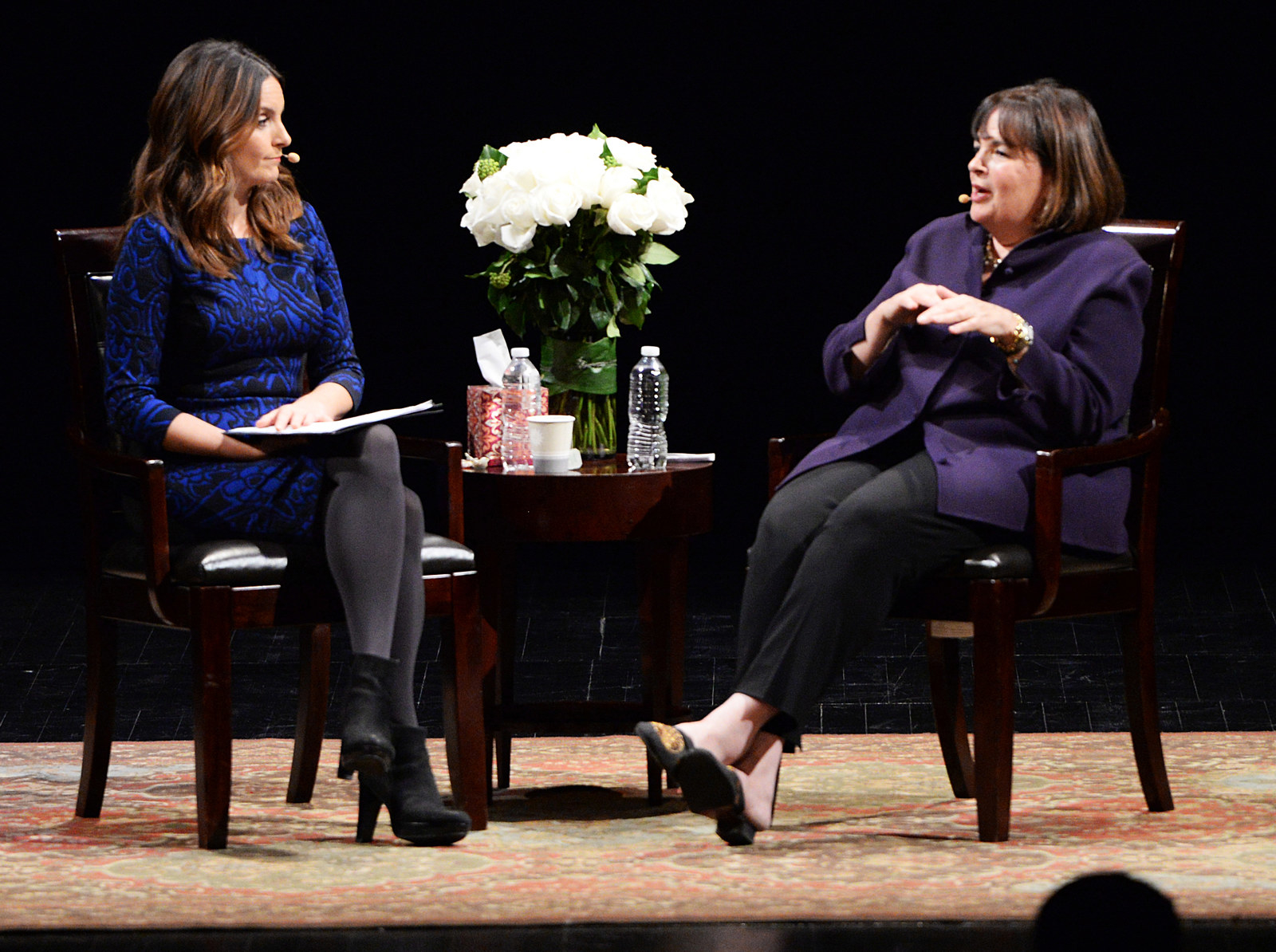
Tina’s first question that night was about Jeffrey. She remarked how “foxy” he looked on the cover of the book. Ina continued to nervously laugh. They talked through the myth — meeting Jeffrey at 16, the wedding, the camping trip. “It’s so charming and now it’s probably illegal,” Tina quipped. They talked about what they stress-ate during the debates. Tina eventually used the phrase “my Jeffrey” to refer to her own husband. Tina also spoke about how Ina and Jeffrey seemed to have the “ideal” relationship “in part because he’s gone Monday through Friday.” Tina asked Ina about her decision to make this book all about him.
“Cooking for him really created my career,” Ina responded. “He’s why I have this amazing life that I have. I wanted it to be a love letter to him.”
I wrote it down and noticed it was the same phrase I’d said to her a few months before.
“What are you most proud of?” Tina asked.
“I think the thing I love is when people stop me and then proceed to say I’ve taught them how to cook,” she said. “It’s an unintended consequence and the thing I love the most.” She beamed, and the applause was laced with cheers and screams.
It was the audience’s turn to ask her questions now; the room was electric. Ina reiterated instructions we’d already been given, that only a few people were to wait at the mics at a time. Her concern, it seemed, was that a line of people would block others of us from being able to see. Everyone followed obediently.
“I’m one of the 600 gay men here this evening,” said one of the first people to ask a question. It would become a running joke, as man after man who came to the mic identified himself as gay, the house laughing and happy. “How do you feel about being a gay icon?” one asked.
“I don’t know,” Ina smiled. “It’s very nice.”
Those who approached the mics were practically bowing. One audience member stated that being here tonight was his partner’s surprise birthday present; another said it was their mother’s 70th birthday this evening. Somebody asked a question about how Ina and Jeffrey deal with issues in their marriage.
“We don’t have dogs and cats and kids and things that make it messy,” Ina said lightheartedly, before answering, “We don’t have issues.”
Ina now mentioned that Jeffrey was here, actually. Everybody tittered and seemed to crane forward, wondering if she meant he was in the front rows. She beckoned him from the wing. The house was already howling, and the man himself walked out — Jeffrey. He embraced his wife and sat beside her, and at that point the room, its pitch, seemed to explode. ●
